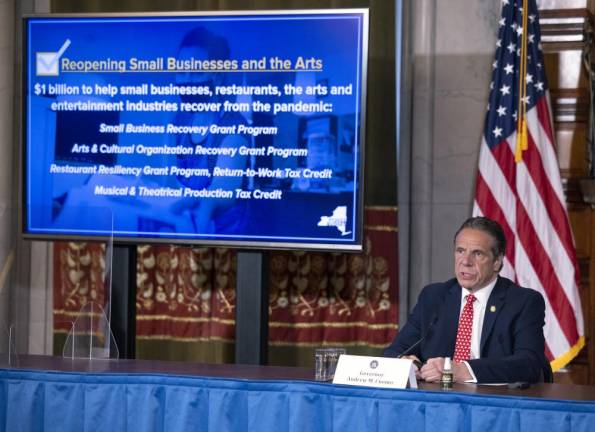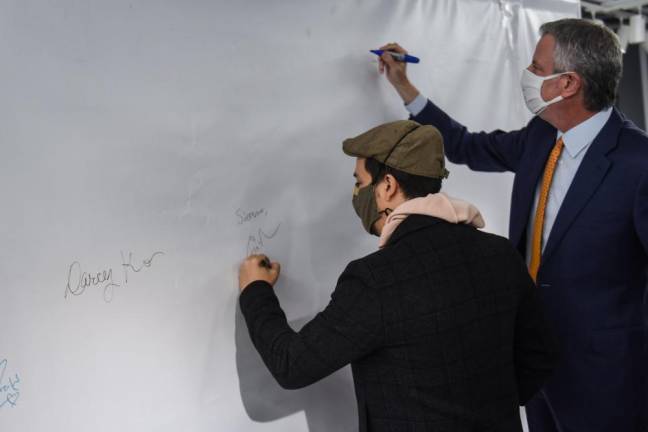The change was palpable. Governor Andrew Cuomo, Emmy award- winning communicator of the pandemic, seemed frustrated, or at least resigned.
“We’re at a point now where we’ve communicated all the information that we can communicate and everyone knows the facts,” Cuomo said Friday. “We’ve asked New Yorkers to continue to take the risk seriously, but it is now up to each of us. It’s up to you as an individual, you as a family, you as a community.”
It’s tempting to attribute this it’s-on-you message to the Governor’s politically reduced circumstance as scandals pound him. But that would miss the broader shifts underway as New York and the country begin the second year under COVID-19.
The governor’s declining stature is just one of many changes a year has wrought. New Yorkers, and most of the country, have grown weary of government-directed lockdowns. Cuomo was one of several Democratic governors who moved away in recent days from embracing dramatic shutdowns of the sort they imposed a year ago. “We’re in a different moment,” said Governor Gretchen Whitmer of Michigan.
But not an easy one, as Whitmer well understands. Coronavirus remains widely present. The average number of confirmed and probable cases, hovering around 3,000 in New York City, is well down from the peak of 6,400 in January (and 5,500 hundred at the peak a year ago). But it is still disturbingly above the rate of cases last September, which were under 300 a day.
The Democratic lean-away from lockdowns seems less about the continuing need to slow the spread – remember flatten the curve? – than a recognition that citizens won’t comply any longer with such orders.
So if citizens are less inclined to listen, the best spin, adopted by Democrats from New York to Colorado was to push responsibility back down on individuals. “Everyone of us has the ability and knowledge to do what it takes,” as Whitmer put it.
“We know how the virus spreads,” Cuomo said Friday, “so it is simply a question of behavior and precautions if we hope to stop the spread as we vaccinate New York. The more precautions each of us take, the fewer people get infected.”
“Community Duty”
The governor, like most New Yorkers, is now hanging a great deal of hope on vaccines.
“Our recovery is going to be a function of how many vaccinations we take,” he said, “and I believe that there is a civic and community duty for each of us to take a vaccine. We’ll only be safe when everyone is safe.”
On this front it is fair to say that progress is patchy, and not fast enough to justify easing non-pharmaceutical speed bumps to viral spread, like masks, distancing and restrictions on gathering, particularly indoors.
The supply of vaccine has improved enough that on Saturday the city invited any New Yorker over 50 to just walk into city-run clinics and get jabbed. This may help draw some New Yorkers who have found it daunting to crack the digital appointment maze.
But at the same time, the city’s effort to bring vaccines to those who are reluctant to come get them was set back when the Johnson & Johnson vaccine was temporarily shelved after six cases of dangerous blood clotting in the brain were identified among 7 million recipients of the vaccine nationwide.
“The pause on the administration of the Johnson & Johnson vaccine is a major blow to vaccination in New York City,” declared Mark Levine, chair of the City Council Health Committee. “In particular, this will be a setback for efforts to increase the equitable distribution of vaccines. Vaccination for the homebound, people being discharged from hospitals, incarcerated individuals, those experiencing homelessness ... all have relied primarily on the J&J shots.”
Vaccine Disparities
Overall, about one in four New York residents has been fully vaccinated. About two million people.
However, even a cursory look at the city’s data on who is getting vaccinated and where shows a variety of disparities. White New Yorkers have been vaccinated at about their presence in the city’s population, while black and Hispanic New Yorkers trail far behind their portion of the population and Asians are well ahead.
“The timing of this disruption is particularly unfortunate, at a moment when vaccination is transitioning from those who have been motivated to find an appointment on the web, to those the City has to work harder to reach,” Levine said. “We need to redouble our efforts to vaccinate those being left behind in New York City.”
One of the striking disparities becomes apparent when vaccination rates are presented by borough. Manhattan residents, of all races, are well ahead of the rest of the city in being vaccinated.
Mayor Bill de Blaiso announced last week that as more locations opened up, no New Yorker would live more than a mile from a vaccine site. The Mayor had announced that the city was depending on the Johnson & Johnson vaccine to supply mobile vaccine buses to reach areas with low vaccination rates.
But on Thursday he expressed less alarm than Levine about the loss of the Johnson & Johnson jabs. “It’s clearly slowed us down a little bit, but not much,” he said Thursday. “We are going to keep moving forward. We’re just going to roll right past this. We’ve got other supply that’s actually increased for Moderna and Pfizer. That’s great. So, it doesn’t change our game plan.”
“We know how the virus spreads, so it is simply a question of behavior and precautions if we hope to stop the spread as we vaccinate New York.” Governor Andrew Cuomo

